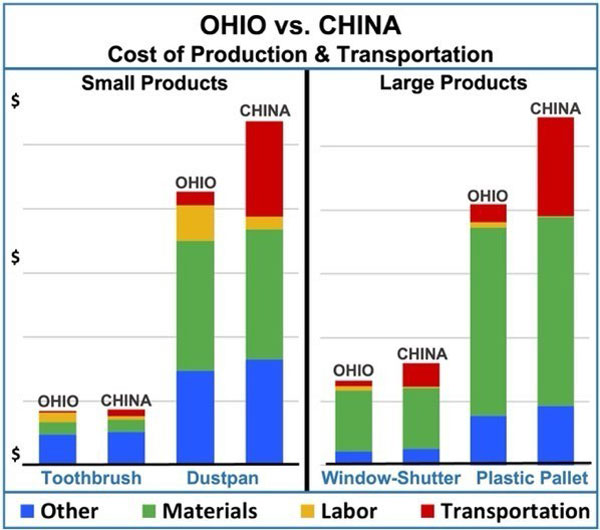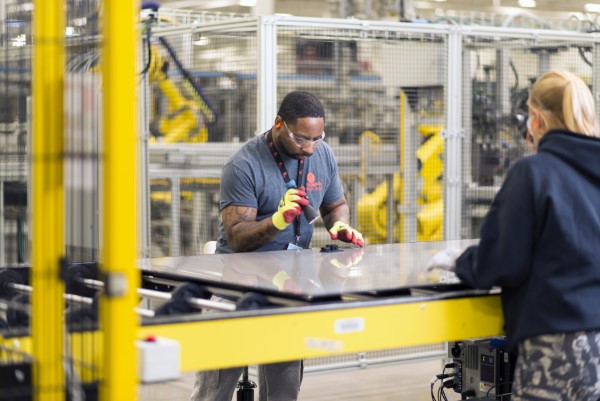ADecember 2022 study from Shale Crescent USA stated it plainly: “The low-cost gas and natural gas liquids flowing from the U.S. shale gas revolution have the potential to turn the $53 billion U.S. plastics importing industry on its head.”
Why? Because, the study showed, those energy resources — plus 35% lower average electricity rates and 28% lower average manufacturing lease rates — make it less expensive to produce plastics in Ohio than in China, a place that accounts for $25 billion of that import total. In 2021, Ohio’s shale gas production accounted for 96% of the state’s natural gas withdrawals, says the U.S. Energy Information Administration. “Overall, natural gas production in Ohio was 27 times greater in 2022 than in 2012, primarily because of production from shale formations.”
 Source: Shale Crescent USA
Source: Shale Crescent USA
“Ohio businesses and manufacturing facilities are located within a day’s drive of 60% of the U.S. population and over 70% of the end-to-end plastics industry supply chain,” the Shale Crescent USA study pointed out. “That same radius also captures over one-third of the U.S.’s natural gas production, creating substantial environmental advantages by eliminating the need for lengthy, fragile transcontinental supply chains and their associated greenhouse gas emissions. This gives Ohio-based plastics manufacturers a tremendous ESG advantage over Chinese competitors and gives their U.S.-based industrial customers an immediate reduction in their Scope 2 greenhouse gas emissions footprint when they switch to Ohio-based plastics suppliers.”
Other footprints are falling into place to help Ohio set the pace for the clean energy transition and the clean-tech economy that goes with it.
In the space of a few months in 2023, the Appalachian Regional Clean Hydrogen Hub (ARCH2) was selected by the U.S. Department of Energy as one of seven regional clean hydrogen hubs that will receive $7 billion in Bipartisan Infrastructure Law funding and Akron’s Sustainable Polymers Tech Hub was selected by the U.S. Economic Development Administration as one of 31 Regional Innovation and Technology Hubs nationwide, with the added bonus of a federal Strategy Development Grant to move the hub forward.
ARCH2, led by Columbus-based Battelle and eligible for up to $925 million in U.S. DOE grants, will help accelerate the domestic market for low-cost, clean hydrogen. It is anticipated to bring quality job opportunities to workers in coal communities and create more than 21,000 direct jobs — including more than 18,000 in construction and more than 3,000 permanent jobs. The project has wide-ranging support from the administration of Ohio Gov. Mike DeWine and Ohio’s business community, including the Ohio Clean Hydrogen Hub Alliance (OH2Hub), comprising 200 public and private entities.
“Due to our vast natural resources and manufacturing opportunities, Ohio amplifies the impact of ARCH2 as a clean hydrogen hub,” said Ohio Chamber of Commerce CEO Steve Stivers as the coalition prepared its application in late 2022. “As energy technology rapidly evolves, it is crucial for Ohio’s workforce and economic development that our energy infrastructure evolves too,” added Pat Tiberi, president and CEO of the Ohio Business Roundtable. “The ARCH2 hydrogen hub is a perfect example of diversifying our energy portfolio and doing so with clean energy.”
The Akron-based Sustainable Polymers Tech Hub aims to magnify the region’s leadership in plastics and polymers while breaking new ground in addressing environmental concerns. “This funding will energize our ability to solve industry-wide challenges and drive innovation in priority areas like sustainability, which is a business imperative for our company and many others,” said Richard J. Kramer, chairman, CEO and president, The Goodyear Tire & Rubber Company.
 Founded a quarter-century ago in Perrysburg, Ohio, First Solar is now the most valuable solar company in the world and continues to grow its footprint in northwest Ohio.
Founded a quarter-century ago in Perrysburg, Ohio, First Solar is now the most valuable solar company in the world and continues to grow its footprint in northwest Ohio.
Photo courtesy of First Solar and Business Wire
Northwest Ohio is Major Hub for Solar MVP
In May 2024 it became official: Photovoltaic module manufacturer First Solar became the most valuable solar manufacturer in the world, attaining a market capitalization of more than $21.1 billion to overtake Chinese manufacturers for the first time since 2018.
The Arizona-based company is just one part of a solar industry ecosystem on the rise in the state.
The Solar Energy Industries Association and Wood Mackenzie said “a record-shattering 32.4 gigawatts of new electric generating capacity” was installed in 2023 by the U.S solar industry, a 51% increase from 2022 and 37% increase from the previous record set in 2021. Triggered by the Inflation Reduction Act among other factors, “total U.S. solar capacity is expected to grow to 673 GW by 2034, enough to power more than 100 million homes,” said the organizations in March. SEIA noted that Ohio was among the top 10 solar states in 2023 for the first time in over a decade, reaching No. 5 in installed solar capacity with 1.3 GW installed during the year, a 1,230% increase.
First Solar in 2024 anticipates attaining over 7 GW total capacity in the state, part of the 14 gigawatts of fully vertically integrated U.S. solar manufacturing capacity the company expects to have by 2026. The company is investing up to $370 million in a dedicated R&D innovation center in Perrysburg, which is expected to be completed in 2024 and create 180 new jobs at an average hourly wage of $42.87 per hour. Multiple manufacturing and R&D expansion projects from the company over the past decade have received support from JobsOhio in the form of economic development and workforce training grants.
In early 2024, First Solar acquired a 1.2-million-sq.-ft. facility in Troy Township formerly known as Peloton Output Park to repurpose it as a new distribution center serving First Solar’s three-site Ohio manufacturing footprint.
“As we prepare to expand our Ohio capacity by almost a gigawatt this year, there’s a need for our logistics and distribution capabilities to scale to match manufacturing growth,” said Mike Koralewski, chief supply chain officer of First Solar. “We intend to use this facility to ensure the efficient and timely shipping of modules to our customers, repurposing it into a dedicated distribution hub for the largest solar manufacturing footprint in the Western Hemisphere … In the long term, the flexible space that the facility affords us could also serve as a light-scale satellite manufacturing location with the potential to support our factories and R&D center in Ohio.”
A recently commissioned study found that in 2023, with 2,700 employees (more than 2,200 of them in Ohio) and almost $490 million in direct labor income, every non-construction First Solar job supported six direct, indirect, and induced jobs across the U.S. economy. The company added $2.75 billion in value and $5.32 billion in output to that economy during the year, including direct, indirect and induced effects. With the company expected to directly employ 4,100 people across the country by 2026, it would support an estimated 30,060 direct, indirect and induced jobs.

